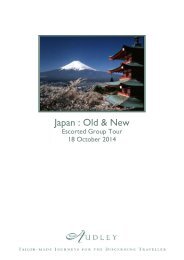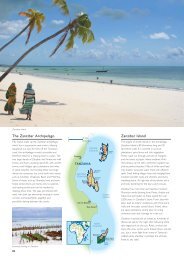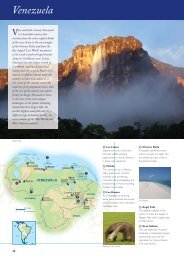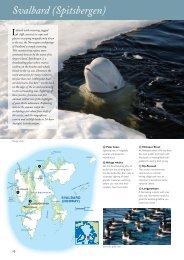Download - Audley Travel
Download - Audley Travel
Download - Audley Travel
You also want an ePaper? Increase the reach of your titles
YUMPU automatically turns print PDFs into web optimized ePapers that Google loves.
Japan through the seasons<br />
Cherry blossom in Ueno Park, Tokyo<br />
Ask any Japanese person to tell you a few facts<br />
about their country and they will invariably<br />
mention the dramatic contrasts of their four<br />
seasons. There really is something very special<br />
about the changing of these, especially for those<br />
of us used to Britain’s less distinct ones. Japan is<br />
resplendent throughout the year, proudly<br />
showing off the changes in each passing season<br />
like a peacock fanning its feathers. Although<br />
each season has its draws, it is spring and the<br />
ephemeral cherry blossom that brings visitors<br />
flooding to Japan every year.<br />
Young girls in kimono during spring festival<br />
Rice farmer, Tohoku<br />
Spring<br />
There is a phrase in Japanese, sakura zensen,<br />
meaning cherry blossom front, which describes<br />
the blossom’s movement from the tip of the<br />
Okinawa in early February all the way to the<br />
most northerly cape of Hokkaido by the end of<br />
May. The peak viewing time in Kyoto and Tokyo<br />
is from the end of March through to the middle<br />
of April. To spend a lazy afternoon wandering<br />
through Tokyo’s Ueno Park or Kyoto’s<br />
Maruyama Park is to truly understand just how<br />
much, and why, the Japanese love this delicate<br />
and transient flower. Spring temperatures range<br />
from the decidedly chilly to warm and pleasant,<br />
with showers common throughout March<br />
and into April.<br />
Summer<br />
In the summer months of June, July and August,<br />
the air becomes stickier and heavy and the<br />
temperatures move steadily towards the upper<br />
twenties. Japan’s rainy season typically occurs in<br />
late June and July on the mainland and with it<br />
comes humidity of more than 80 percent, with<br />
temperatures nudging 40C on some days.<br />
Although not typically one of the most popular<br />
seasons for travel to Japan, there is something<br />
exotic about the Japanese summer months.<br />
This really feels like the Far East as one would<br />
expect it; the constant chirping of cicadas, the<br />
croaking of frogs from lush green paddy fields,<br />
and glorious sunshine. It is possible to escape<br />
the heat and humidity by heading for Japan’s<br />
mountains or coast, so you need not melt in<br />
the cities.<br />
Summer also brings with it a host of colourful<br />
local festivals, particularly in the cooler Tohoku<br />
region. The festivals are superb occasions to be<br />
a part of, passing in a whirl of dancing, music<br />
and beautiful traditional costumes.<br />
28

















